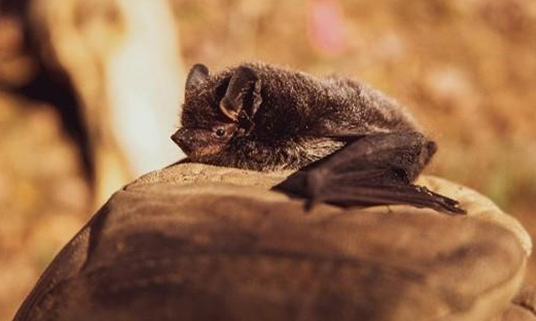
Nearly 130 years ago, Bram Stoker’s Dracula was published and has stoked the fire of horror fans’ enthusiasm all over the world ever since. While the classic book inspired many movie adaptations, characters and more magical tales, it also created a PR disaster for the much-misunderstood bat.
Many may be surprised to learn that, despite their maligned reputation, bats actually carry out important work and contribute wonders to our ecosystem’s health. By consuming their favourite food – insects – crop yields are improved, plants can be saved and farmers are able to use fewer pesticides. They also pollinate plants and disperse seeds, contributing to the natural health of our planet. In fact, in the UK, some bats are ‘indicator species’, meaning that changes to these bat populations can indicate changes in aspects of biodiversity.
Around the world there is a huge diversity of bats, with the UK’s 17 resident types of bat accounting for a quarter of our native mammal species. Despite this incredible biodiversity, bat populations have seen a rapid decline over the last century due to human activity, including building work, the loss of roosting sites and the decrease of suitable habitats.
Clearly then, it is important for people to do all that they can to protect these vital mammals, and experts CJ Wildlife are sharing their top tips to help Britain care for its bats.
Create a home for bats
With natural bat habitats across the UK diminishing, even those without a garden can do their bit to create a home for these furry mammals.
Bat boxes are important for a number of different reasons. They reduce bat-human interaction, allowing these mammals to remain as ‘wild’ as possible. They also give females a safe space to safely raise and feed their young, and provide a warm and secure place for bats to roost during the day in the summer.
When choosing a box it is important to pick materials that allow bats to grip onto and keep predators out.
Try a bat box with a ladder beneath for landing like the Coucy Wooden Bat Box, which offers extra protection as bats can easily grip onto the box and slip through to enter. In early summer, pregnant bats will gather in a ‘maternity roost’ so larger boxes like the Almodovar Wooden Bat Box might be best if there is a larger population in the area.
In many ways, a well-used bat box is often governed by the same rules as a desirable human home – location, location, location. The experts at CJ Wildlife recommend siting your bat box in a sturdy tree or building where bats have been seen or are known to feed. They also suggest that a sheltered south or southwest spot is best, to ensure that the box is exposed to direct sunlight throughout the day. Lastly, if it is possible, putting a bat box near a wet area, such as a pond or marshy environment, will attract insects favoured by bats and will also provide them with somewhere to drink.
Bats go into hibernation to survive the winter, meaning their body temperature is considerably lowered. To survive the cold, they require consistent temperatures inside the roost. The Harlech WoodStone® Bat Box is made from a combination of concrete and FSC®-certified wood chippings, ensuring the internal temperature remains consistent for hibernating bats.
Make your garden into a bat haven
Over the last century, the wooded areas, ponds and open green spaces that bats use to feed in and make homes in have unfortunately been shrinking. However, with an estimated 15 million gardens and 27 million gardeners across the UK, this green-fingered army is in a unique position to create a network of gardens to provide green corridors for bats and many other species.
Planting night-scented flowers, such as evening primrose and honeysuckle, will encourage nocturnal visitors like moths, which will in turn provide a tasty treat for local bats. Some night-scented flowers also offer beautiful blooms throughout the day, making them not just pretty, but useful too!
Building a pond not only provides a water source for bats, but will also encourage other aquatic creatures too. Ponds are a fantastic home for midges and aquatic larvae, which are favourites of the pipistrelle bat – this impressive creature can eat thousands of insects in a single night!
The experts at CJ Wildlife also encourage gardeners to let patches of ground – or perhaps even the whole garden – go a little wild, providing a home for more insects, larvae and wildlife, including bats. Wildflowers attract a whole host of creatures which can help to sustain our bat populations.
Start a compost heap if possible. Not only is this good for the environment and can use up any bits of food waste, it will also provide a handy home for insects – creating a tasty snack for a bat.
Another way to encourage insects and help feed bats is by adding established trees and shrubs to your garden. These provide shelter for insects that can use them to lay eggs and reproduce, attracting even more bugs for bats to feast on. Retain mature trees wherever possible, as bats can use handy hollows to roost in.
Inspire the next generation
Get children involved and stimulate curiosity in the natural world by asking them to help with building their very own bat box. The Igor Bat Box Building Kit is a practical project which adults and children can work on together – with custom made parts and pre-drilled holes, it takes just a little time and effort to make, plus a hammer and a Phillips screwdriver! Once it’s built, children can use their imagination and creativity to decorate the box with paint or markers, giving them a unique project which also helps the wildlife around them.
For more advice on attracting bats to your garden and to browse CJ Wildlife’s bat box collection visit the website.





